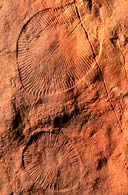Recently, Sam Bowring dated thin volcanic ash beds below, within, and above the Gaskiers glacial deposits in Newfoundland, finding that ashes from 8 meters below the glacial deposits to 10 meters above have ages within error of one another and cluster near 580 Ma. These are the first high-precision temporal constraints on the age and duration of a Neoproterozoic glaciation. The oldest known Ediacaran fossils lie approximately 100-200 meters above the glacials and are 575 Ma, leaving approximately 5 Ma between the last glacial deposit and the initial expansion of large animals.
 The dramatic diversification of animal phyla during early Cambrian
time has fueled debate regarding the mechanisms of early animal evolution
for over a century.
What is now clear is that intrinsic catalysts, such as the innovation
of developmental genetic mechanisms, as well as extrinsic processes,
involving environmental change, are both critically important in accounting
for this major event in the history of life. Recent attempts to delineate
potential extrinsic factors have revealed a large-magnitude, but short-lived
negative excursion in the carbon-isotopic of seawater that is globally
coincident with the Precambrian-Cambrian boundary. Possible mass extinction,
in some manner related to this negative isotope excursion, has been
invoked as a contributing mechanism that led to rapid diversification
of metazoans within restructured early Cambrian ecosystems. Our research
on biostratigraphic, geochemical and
geochronometric data from Oman supports this hypothesis, indicating
an extinction of terminal Proterozoic calcified metazoans coincident
with this boundary isotope excursion at about 542 Ma.
The dramatic diversification of animal phyla during early Cambrian
time has fueled debate regarding the mechanisms of early animal evolution
for over a century.
What is now clear is that intrinsic catalysts, such as the innovation
of developmental genetic mechanisms, as well as extrinsic processes,
involving environmental change, are both critically important in accounting
for this major event in the history of life. Recent attempts to delineate
potential extrinsic factors have revealed a large-magnitude, but short-lived
negative excursion in the carbon-isotopic of seawater that is globally
coincident with the Precambrian-Cambrian boundary. Possible mass extinction,
in some manner related to this negative isotope excursion, has been
invoked as a contributing mechanism that led to rapid diversification
of metazoans within restructured early Cambrian ecosystems. Our research
on biostratigraphic, geochemical and
geochronometric data from Oman supports this hypothesis, indicating
an extinction of terminal Proterozoic calcified metazoans coincident
with this boundary isotope excursion at about 542 Ma.
